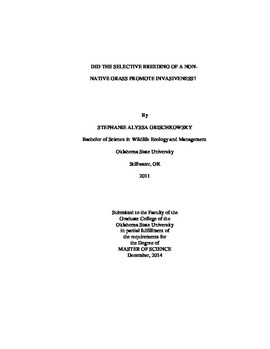| dc.contributor.advisor | Hickman, Karen R. | |
| dc.contributor.author | Grischkowsky, Stephanie Alyssa | |
| dc.date.accessioned | 2016-01-20T15:44:34Z | |
| dc.date.available | 2016-01-20T15:44:34Z | |
| dc.date.issued | 2014-12-01 | |
| dc.identifier.uri | https://hdl.handle.net/11244/25654 | |
| dc.description.abstract | Concerns with invasive species have included exotic forage grasses that have undergone extensive breeding through development programs for greater success of establishment. These grasses have been widely distributed for soil erosion control and livestock forage production throughout the United States and many of these species have become invasive in native habitats. To determine whether plant breeding procedures increased the invasiveness of these exotic grasses relative to their native counterparts, we assessed the competitiveness of an old world bluestem (Bothriochloa ischaemum; OWB) a known invader of the Great Plains in the United States, relative to its "wildtype" from the Czech Republic, and two native tallgrass prairie grasses (big bluestem [Andropogon gerardii] and little bluestem [Schizachyrium scoparium]). To assess inter-and intraspecific competition a substitutive design greenhouse competition experiment was conducted in Stillwater, Oklahoma with partners from the Czech University of Life Sciences. Growth of the invasive B. ischaemum was enhanced when grown with the native S. scoparium. However, the Czech Republic wildtype did not exhibit increased production when grown in competition with natives compared to conspecifics, suggesting the extensive breeding of B. ischaemum may have enhanced its competitive abilities. To further assess plant-soil feedbacks we conducted a second greenhouse study which examined soil biotic communities using soil inoculums associated with either wildtype or invasive B. ischaemum cultivars. Growth and reproduction of native grass species, the wildtype, and invasive B. ischaemum were assessed 16 weeks following inoculation with soil microbial communities. Phospholipid and neutral lipid fatty acids were quantified at the end of the study to determine microbial biomass associated with each soil inoculum and species or cultivar combination. Total biomass production and abundance of AMF was enhanced when the wildtype was grown with inoculum associated with the invasive cultivar compared to wildtype inoculum, indicating the wildtype favors soil biotic communities associated with the invasive cultivar. When assessing responses of native grasses, A. gerardii illustrated greater production and abundance of AMF compared to S. scoparium suggesting seeding to A. gerardii may lead to greater success in grassland restorations following eradication of B. ischaemum, compared to restorations seeded to S. scoparium. | |
| dc.format | application/pdf | |
| dc.language | en_US | |
| dc.publisher | Oklahoma State University | |
| dc.rights | Copyright is held by the author who has granted the Oklahoma State University Library the non-exclusive right to share this material in its institutional repository. Contact Digital Library Services at lib-dls@okstate.edu or 405-744-9161 for the permission policy on the use, reproduction or distribution of this material. | |
| dc.title | Did the Selective Breeding of a Non-native Grass Promote Invasiveness? | |
| dc.type | text | |
| dc.contributor.committeeMember | Wilson, Gail W. T. | |
| dc.contributor.committeeMember | Wilson, Duncan | |
| osu.filename | Grischkowsky_okstate_0664M_13754.pdf | |
| osu.accesstype | Open Access | |
| dc.description.department | Natural Resources and Ecology Management | |
| dc.type.genre | Thesis | |
